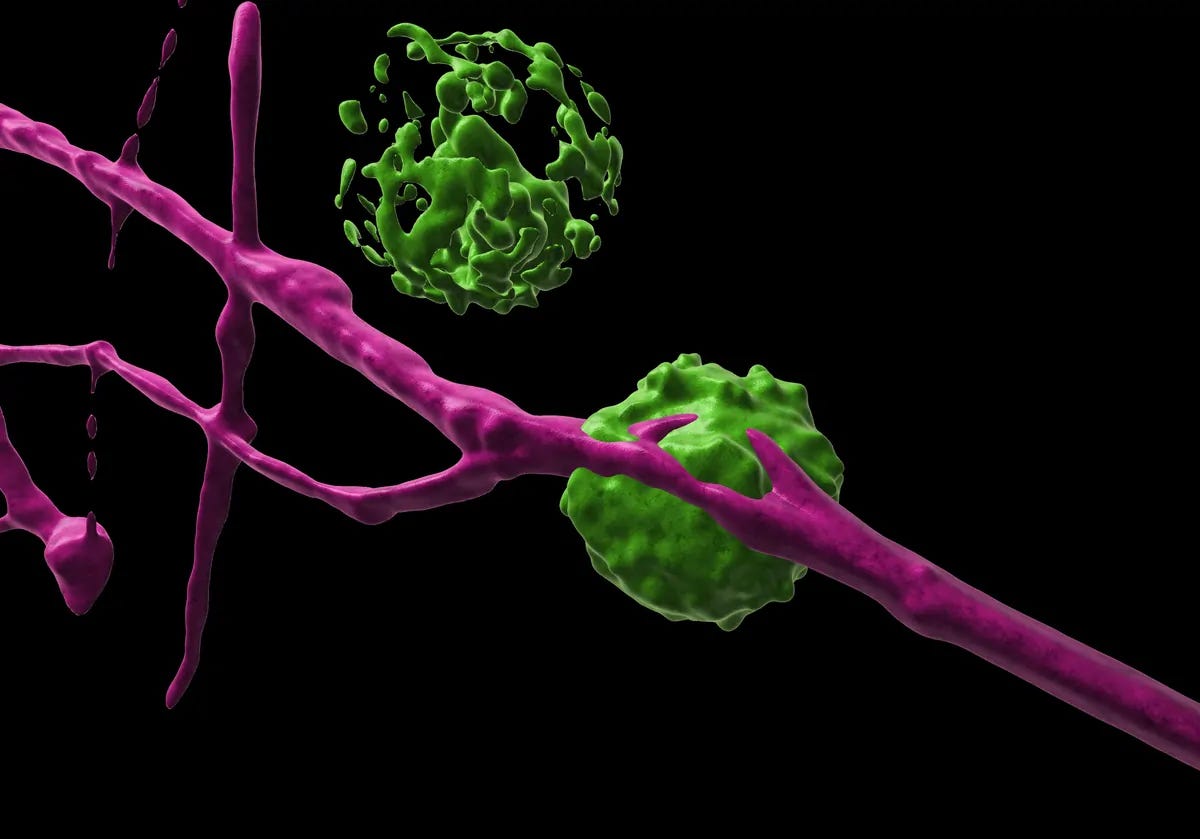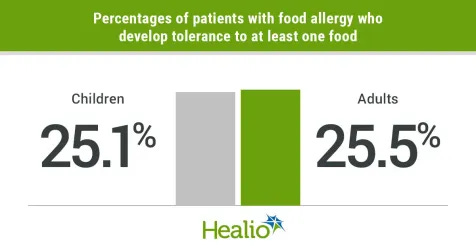Sci-Ed Update 263
Goodbye food allergies, goodbye microbiome, hello Mastodon, brain connections & body image, false memories, avoiding clots while immobile, eye evolution, & the uncertainty effect
About one-quarter of patients outgrow food allergies
8.2% of children and 14.7% of adults outgrow their peanut allergy.
30.6% of men and 22% of women outgrow their allergy.
Patients with incomes of $150,000 or more are most likely to outgrow their allergy.
Read more→ AandP.info/o7u
How Cells in the Skin Team Up To Fight Pathogens
Immune cells and pain neurons form complex partnerships to protect our bodies from pathogens, new research reveals.

Skin shields our bodies from the world’s dangers, but sometimes, with a nick or a bump, that barrier is breached. That’s when pain- and itch-sensing nociceptor neurons jump to action, transmitting threat signals to the central nervous system, while dendritic cells eliminate pathogens by secreting cytokines and coordinating local inflammation, while also playing a role in adaptive immunity.
But this work is not done in isolation: Dendritic cells (DCs) and nociceptors are entangled in a powerful partnership, and a new study published March 31 in Science describes three unique ways these intertwined cells communicate to fine-tune the fight against invaders.
Read more→ AandP.info/kz6
The shocking decline of Earth’s microbiome – and how to save it
Bacteria, fungi and other microbes, which are vital to life on Earth, were long thought impervious to threats endangering larger lifeforms. Now biologists are warning of a microbial extinction event
For a long time, bacteria, fungi and other microbes were thought to be impervious to the agents of extinction wreaking havoc on larger organisms. They are so abundant and reproduce so quickly, the thinking went, that they couldn’t possibly be threatened. In recent years, however, microbiologists have come to question this assumption – and now they are sounding the alarm that microbe populations are in decline, possibly precipitously.
“We’re starting to see scary signals that there may be this large microbial extinction event under way that we barely noticed,” says Colin Averill, an ecologist at ETH Zurich in Switzerland.
Read more→ AandP.info/174
How I found a new home online at Mastodon, after giving up on Twitter
More like a village than a city, Mastodon has less cruelty and bad-faith debates than Twitter, in my experience Could it be a social media platform to trust, asks Annalee Newitz
As I set up my Mastodon account and searched for people to follow, it was as if I found myself on a wide boulevard with shady trees, odd little storefronts and laboratories full of chatty scientists who wanted to tell me about their research. I reconnected with people I had known years ago, but lost in a previous social media abandonment era. I made delightful new acquaintances. We joked about The Mandalorian and made software puns and discussed our jobs.
After a few weeks of friendly patter and small talk, I got into a complicated debate on Mastodon about the politics of social media. A post of mine had gone viral and a lot of people were replying. I braced myself for Twitter-style abuse and bad faith clapbacks that didn’t actually address the concerns I had raised.
Hours went by, then days. Plenty of people disagreed with me, but generally they did it by explaining their own positions and making suggestions about how I could rethink my own. I found myself reconsidering my ideas. I learned a lot. Slowly, I stopped cringing at the gargantuan discussion thread I had spawned. Instead, I looked forward to reading what people had to say.
What is this strange feeling I am having on a social media platform, I wondered. Then I realised: it was the first glimmer of trust.
Read more→ AandP.info/88l
Follow The A&P Professor on Mastodon!
Check it out now→ The A﹠P Professor (@theAPprofessor@qoto.org)
From the body’s viscera to the body’s image: Is there a link between interoception and body image concerns?
Interoception, the sense of the physiological condition of the body originating from within its internal organs, and body image, namely the perception, feelings and attitudes one has about one’s body, are two fundamental components of our sense of personal identity and overall well-being. However, the relation between interoception and body image remains poorly understood.
We [in this study] review recent behavioural and neuroimaging evidence from non-clinical and clinical populations (e.g. eating disorders) to propose that basic interoceptive processes and interoceptive awareness may crucially contribute to the complex formation of body image, as well as to its disturbances. In particular, lower interoceptive accuracy and awareness are associated with body-image concerns.
We provide a potential mechanistic explanation of the link between interoception and body image, which aims to integrate interoceptive and exteroceptive representations of the body. The suggested link between interoception and body image can inform new empirically testable hypotheses on the underlying neurocognitive processes that are central to body image concerns and disturbances, and motivate relevant clinical implications.
Read more→ AandP.info/oeg
Your Brain Can Create a False Memory Quicker Than You Think
Research suggests people can generate false memories within the blink of an eye.
In a series of four experiments led by the University of Amsterdam, researchers showed 534 people letters of the Western alphabet in actual and mirrored orientations.
After some participants were shown an interference slide with random letters designed to scramble the original memory, all participants were asked to recall a target letter from the first slide.
Half a second after viewing the first slide, almost 20 percent of people had formed an illusory memory of the target letter; this increased to 30 percent after 3 seconds.
The human brain alters memories according to what it expects to see. Because people included in the study were so familiar with the Western alphabet, their brains expected to see the letters in their actual orientation.
When letters appeared mirrored (Ɔ instead of C), people were more likely to remember the pseudo-letter as a real letter, even after only milliseconds had passed.
"It seems that short-term memory is not always an accurate representation of what was just perceived," the researchers write. "Instead, memory is shaped by what we expected to see, right from the formation of the first memory trace."
Read more→ AandP.info/uop
Hibernating bears don’t get blood clots. Now scientists know why
A key clotting protein decreases in the slumbering bears — and other immobile animals
When a brown bear settles down for hibernation, its body makes adjustments to prevent developing dangerous blood clots while immobile, a new study shows.
People stuck sitting in tight airplane seats for an entire long-haul flight are at risk of dangerous blood clots. But somehow immobile, hibernating bears are not. Now scientists know why.
Bears settled in for winterlong slumbers have low levels of a key protein that helps blood clots form, researchers report in the April 14 Science. Platelets lacking this protein don’t easily stick together, protecting the animals from developing potentially dangerous blood clots. And low levels of the protein are not just found bears, the team writes. Mice, pigs and humans with a largely sedentary lifestyle because of long-term mobility problems have the same protection.
Read more→ AandP.info/hzu
Bacterial origin of a key innovation in the evolution of the vertebrate eye
The vertebrate eye was described by Charles Darwin as one of the greatest potential challenges to a theory of natural selection by stepwise evolutionary processes. While numerous evolutionary transitions that led to the vertebrate eye have been explained, some aspects appear to be vertebrate specific with no obvious metazoan precursor.
One critical difference between vertebrate and invertebrate vision hinges on interphotoreceptor retinoid-binding protein (IRBP, also known as retinol-binding protein, RBP3), which enables the physical separation and specialization of cells in the vertebrate visual cycle by promoting retinoid shuttling between cell types. While IRBP has been functionally described, its evolutionary origin has remained elusive.
Here, we show that IRBP arose via acquisition of novel genetic material from bacteria by interdomain horizontal gene transfer (iHGT). We demonstrate that a gene encoding a bacterial peptidase was acquired prior to the radiation of extant vertebrates >500 Mya and underwent subsequent domain duplication and neofunctionalization to give rise to vertebrate IRBP. Our phylogenomic analyses on >900 high-quality genomes across the tree of life provided the resolution to distinguish contamination in genome assemblies from true instances of horizontal acquisition of IRBP and led us to discover additional independent transfers of the same bacterial peptidase gene family into distinct eukaryotic lineages.
Importantly, this work illustrates the evolutionary basis of a key transition that led to the vertebrate visual cycle and highlights the striking impact that acquisition of bacterial genes has had on vertebrate evolution.
Read more→ AandP.info/n3j
It’s the episode everyone is talking about!
To listen to this episode, click on the player (if present) or this link→ theAPprofessor.org/podcast-episode-135.html










